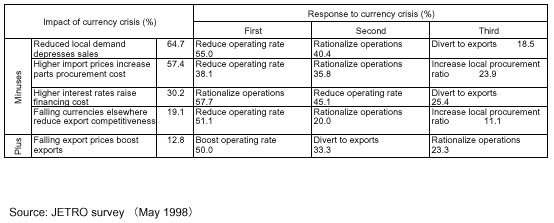- NLI Research Institute >
- The ASEAN Strategies of Electronics Makers- Production Linkages Continue to Deepen After the Currency Crisis-
The ASEAN Strategies of Electronics Makers- Production Linkages Continue to Deepen After the Currency Crisis-
Toshinobu Takahashi
Font size
- S
- M
- L
The ASEAN currency crisis, led by the Thai baht's decline in July 1997, dealt a severe blow to local subsidiaries of Japanese manufacturers. A JETRO survey of Japanese electronics makers one year later revealed that the greatest harm was to production sites supplying the local market (Table 1)

On the other hand, the exportoriented production sites benefited from weak local currencies and turned in good performances.
However, with the ensuing Russian currency crisis in August 1998, followed by the Brazilian currency crisis in September, exports intended for Russia, Eastern Europe and Latin America suffered heavily, amplifying the setback in export markets to a global scale. Thus the export-oriented production sites also suffered as their utilization rates fell.
To examine the condition of Japanese electronics makers in the ASEAN region, NLI Research Institute conducted on-site interviews from October 1998 to February 1999. While the makers all reported that times were tough, we also found that makers - primarily the large makers -were deepening their production linkages with ASEAN.
Toshinobu Takahashi
Research field

















